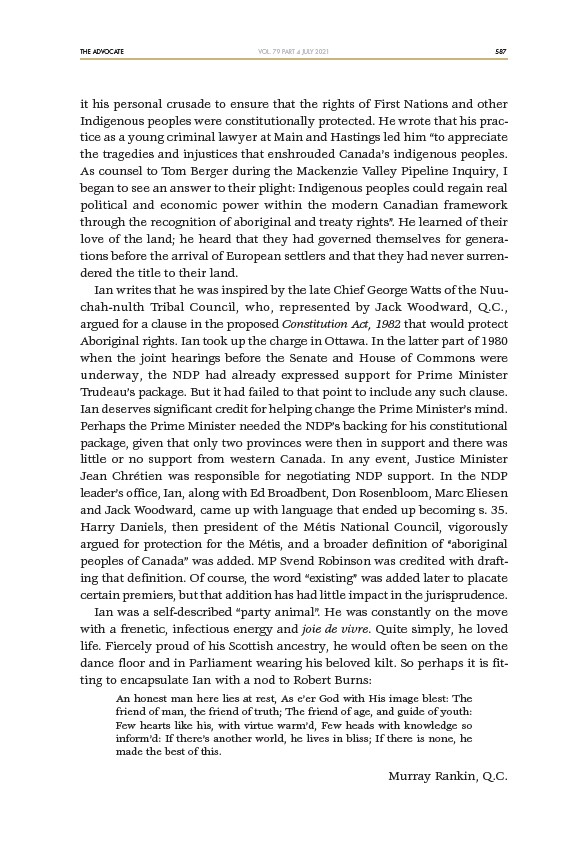
THE ADVOCATE 587
VOL. 79 PART 4 JULY 2021
it his personal crusade to ensure that the rights of First Nations and other
Indigenous peoples were constitutionally protected. He wrote that his practice
as a young criminal lawyer at Main and Hastings led him “to appreciate
the tragedies and injustices that enshrouded Canada’s indigenous peoples.
As counsel to Tom Berger during the Mackenzie Valley Pipeline Inquiry, I
began to see an answer to their plight: Indigenous peoples could regain real
political and economic power within the modern Canadian framework
through the recognition of aboriginal and treaty rights”. He learned of their
love of the land; he heard that they had governed themselves for generations
before the arrival of European settlers and that they had never surrendered
the title to their land.
Ian writes that he was inspired by the late Chief George Watts of the Nuuchah
nulth Tribal Council, who, represented by Jack Woodward, Q.C.,
argued for a clause in the proposed Constitution Act, 1982 that would protect
Aboriginal rights. Ian took up the charge in Ottawa. In the latter part of 1980
when the joint hearings before the Senate and House of Commons were
underway, the NDP had already expressed support for Prime Minister
Trudeau’s package. But it had failed to that point to include any such clause.
Ian deserves significant credit for helping change the Prime Minister’s mind.
Perhaps the Prime Minister needed the NDP’s backing for his constitutional
package, given that only two provinces were then in support and there was
little or no support from western Canada. In any event, Justice Minister
Jean Chrétien was responsible for negotiating NDP support. In the NDP
leader’s office, Ian, along with Ed Broadbent, Don Rosenbloom, Marc Eliesen
and Jack Woodward, came up with language that ended up becoming s. 35.
Harry Daniels, then president of the Métis National Council, vigorously
argued for protection for the Métis, and a broader definition of “aboriginal
peoples of Canada” was added. MP Svend Robinson was credited with drafting
that definition. Of course, the word “existing” was added later to placate
certain premiers, but that addition has had little impact in the jurisprudence.
Ian was a self-described “party animal”. He was constantly on the move
with a frenetic, infectious energy and joie de vivre. Quite simply, he loved
life. Fiercely proud of his Scottish ancestry, he would often be seen on the
dance floor and in Parliament wearing his beloved kilt. So perhaps it is fitting
to encapsulate Ian with a nod to Robert Burns:
An honest man here lies at rest, As e’er God with His image blest: The
friend of man, the friend of truth; The friend of age, and guide of youth:
Few hearts like his, with virtue warm’d, Few heads with knowledge so
inform’d: If there’s another world, he lives in bliss; If there is none, he
made the best of this.
Murray Rankin, Q.C.